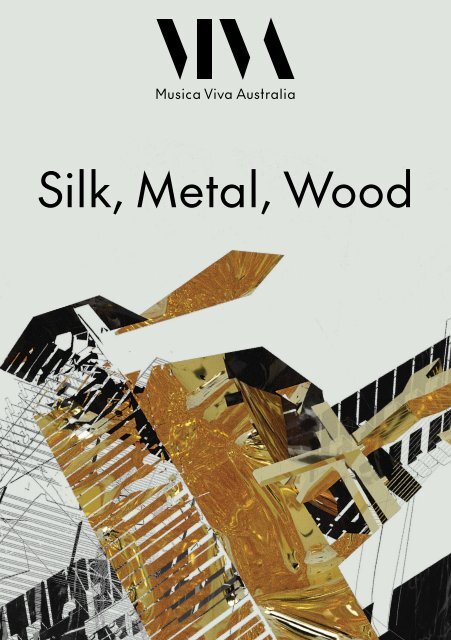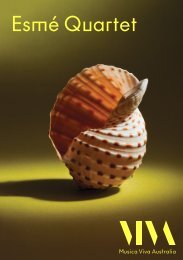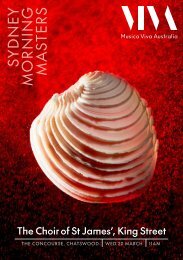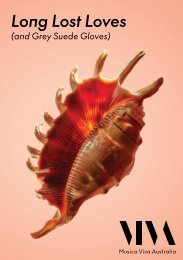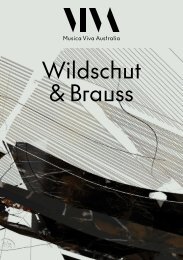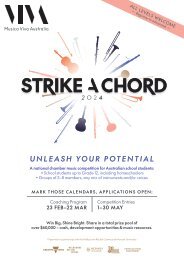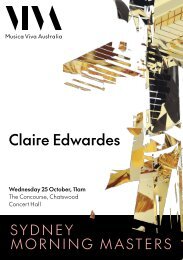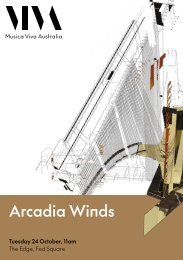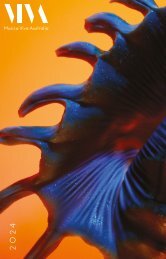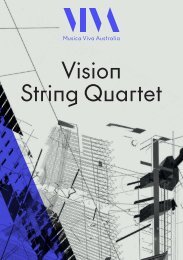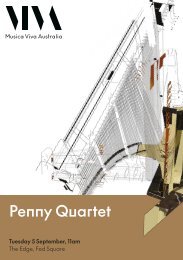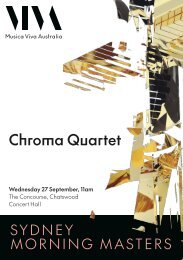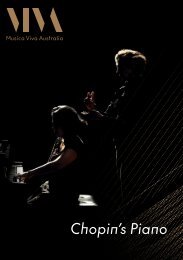Silk, Metal, Wood Program Guide | August 2023
You also want an ePaper? Increase the reach of your titles
YUMPU automatically turns print PDFs into web optimized ePapers that Google loves.
<strong>Silk</strong>, <strong>Metal</strong>, <strong>Wood</strong>
2
Musica Viva Australia acknowledges the Traditional Custodians of the many lands on which we meet,<br />
work and live. We pay our respects to their Elders past and present – people who have<br />
sung their songs, danced their dances and told their stories on these lands<br />
for thousands of generations, and who continue to do so.<br />
SILK, METAL, WOOD<br />
JEAN-GUIHEN<br />
QUEYRAS<br />
cello<br />
SATSUKI<br />
ODAMURA<br />
koto & bass koto<br />
JAMES<br />
MORLEY<br />
cello<br />
MATTHEW<br />
MARSHALL<br />
lighting designer<br />
ADELAIDE<br />
Adelaide Town Hall<br />
Wednesday 23 <strong>August</strong>, 7.30pm<br />
• Pre-concert talk: 6.45pm,<br />
Prince Alfred Room<br />
MELBOURNE<br />
Elisabeth Murdoch Hall,<br />
Melbourne Recital Centre<br />
Tuesday 15 <strong>August</strong>, 7pm<br />
• Pre-concert talk: 6.15pm,<br />
Salzer Suite, Level 2<br />
Saturday 26 <strong>August</strong>, 7pm<br />
Paul Morawetz Tribute Concert<br />
• Pre-concert talk: 6.15pm,<br />
Salzer Suite, Level 2<br />
• Meet the Artists after the concert<br />
NEWCASTLE<br />
City Hall<br />
Thursday 17 <strong>August</strong>, 7.30pm<br />
• Pre-concert talk: 6.45pm,<br />
Mulubinba Room<br />
PERTH<br />
Perth Concert Hall<br />
Monday 21 <strong>August</strong>, 7.30pm<br />
• Pre-concert talk: 6.45pm,<br />
Corner Stage Riverside, Terrace Level<br />
• Meet the Artists after the concert<br />
SYDNEY<br />
City Recital Hall<br />
Monday 14 <strong>August</strong>, 7pm<br />
• Pre-concert talk: 6.15pm,<br />
Function Room, Level 1<br />
• Meet the Artists after the concert,<br />
Concert Hall<br />
Saturday 19 <strong>August</strong>, 2pm<br />
Recorded for broadcast by ABC Classic<br />
• Pre-concert talk: 1.15pm,<br />
Function Room, Level 1<br />
• CD signing after the concert,<br />
Main Foyer<br />
—<br />
With special thanks to the Producers’ Circle and Amadeus Society for their support of the <strong>2023</strong> Concert Season.<br />
01
From the Artistic Director<br />
© Darren Leigh Roberts<br />
I first encountered the brilliant cellist Jean-Guihen<br />
Queyras through a 1998 recording of Britten’s Cello<br />
Suites. This disc swept away its predecessors –<br />
including to my mind the outstanding recordings<br />
made by Rostropovich under the composer’s<br />
supervision. It was so intimate, so tender, so<br />
effortlessly playful yet virtuosic. Listening to it today<br />
– after hearing so many new recordings and concert<br />
performances of the Suites in the intervening years –<br />
I return instantly to the feelings of awe and pleasure<br />
I felt over 20 years ago.<br />
Of course, one of these Suites had to be included on<br />
this recital program; how could it not be? Yet Jean-<br />
Guihen wanted his first Australian tour to include<br />
substantial elements of engagement with Australian<br />
artists and music from the region. His enthusiastic<br />
response to recordings of beautiful koto playing by<br />
Satsuki Odamura led us to set about working out a<br />
collaboration. Composer Jakub Jankowski – himself<br />
a cellist – was our entry point; we commissioned<br />
a work from him for cello and koto, to which he<br />
responded with great enthusiasm and curiosity.<br />
Two cellos, actually; Jean-Guihen responded so<br />
positively to the playing of the young Adelaide cellist<br />
James Morley, now studying in Basel, that we asked<br />
Jakub to write for this unusual line-up. Jean-Guihen<br />
and James will also perform a thrilling duo by<br />
Offenbach, the emerging soloist sitting comfortably<br />
next to one of the great cellists of today.<br />
There is a simple arc to the concert: three musicians<br />
sharing music with each other from their own<br />
cultures/backgrounds, combining in a new work that<br />
brings together all these threads – the silk strings<br />
of the traditional koto, the metal strings of the cello,<br />
and the wood casing of both instruments. We get to<br />
eavesdrop and be enriched by the exchange.<br />
Paul Kildea<br />
Artistic Director<br />
Musica Viva Australia<br />
02
<strong>Program</strong><br />
Please note that the first half of this concert is performed without pause.<br />
Please hold your applause until the end of the half.<br />
Johann Sebastian BACH (1685–1750)<br />
Cello Suite No. 1 in G major, BWV 1007 (1717–23)<br />
I<br />
II<br />
III<br />
IV<br />
V<br />
VI<br />
Prelude<br />
Allemande<br />
Courante<br />
Sarabande<br />
Minuets I and II<br />
Gigue<br />
Yatsuhashi KENGYŌ (1614–1685)<br />
Midare (Disorder)<br />
Jakub JANKOWSKI (b 1994)<br />
Eclogue (<strong>2023</strong>)<br />
Commissioned for Musica Viva Australia by the Adelaide Commissioning Circle<br />
World premiere performances<br />
20 min<br />
10 min<br />
9 min<br />
INTERVAL<br />
Robin WILLIAMSON (b 1943)<br />
Letter from a Stranger’s Childhood (1987)<br />
6 min<br />
Benjamin BRITTEN (1913–1976)<br />
Cello Suite No. 1, Op. 72 (1964)<br />
25 min<br />
I Canto primo: Sostenuto e largamente (First Canto: Sustained and broad)<br />
II Fuga: Andante moderato (Fugue: At a moderate walking pace)<br />
III Lamento: Lento rubato (Lament: Slow, flexible)<br />
IV Canto secondo: Sostenuto (Second Canto: Sustained)<br />
V Serenata: Allegretto pizzicato (Serenade: Fairly fast, plucked)<br />
VI Marcia: Alla marcia moderato (March: At a moderate march pace)<br />
VII Canto terzo: Sostenuto (Third Canto: Sustained)<br />
VIII Bordone: Moderato quasi recitativo (Bourdon: At a moderate pace, like a recitative)<br />
IX Moto perpetuo e Canto quarto: Presto (Perpetual Motion and Fourth Canto: Quick)<br />
Jacques OFFENBACH (1819–1880)<br />
Duo for two cellos in B-flat major, Op. 53 No. 1<br />
I Allegro (Fast)<br />
II Adagio (Slow)<br />
III Rondo<br />
14 min<br />
Please ensure that mobile phones are turned to silent before the performance.<br />
Photography and video not permitted during the performance.<br />
03
Masterclasses<br />
Further Listening<br />
Musica Viva Australia creates opportunities<br />
for Australian and internationally acclaimed<br />
artists to share their experience and expertise<br />
with talented early-career artists and young<br />
music students, creating an enriching learning<br />
experience.<br />
The following masterclasses are presented as<br />
part of this tour:<br />
SATSUKI ODAMURA<br />
• Fri 25 <strong>August</strong>: Melbourne<br />
Victorian College of the Arts<br />
Secondary School (VCASS)<br />
(closed to public)<br />
• Date TBC: Sydney<br />
Sydney Conservatorium<br />
(closed to public)<br />
JEAN-GUIHEN QUEYRAS<br />
• Fri 25 <strong>August</strong>: Melbourne<br />
Monash University<br />
(closed to public)<br />
• Sat 26 <strong>August</strong>: Melbourne<br />
Australian National Academy of Music<br />
(ANAM)<br />
(closed to public)<br />
• Date TBC: Perth<br />
Western Australian Academy of<br />
Performing Arts (WAAPA)<br />
For further details visit:<br />
musicaviva.com.au/masterclasses<br />
Musica Viva Australia’s Masterclass<br />
program is supported by:<br />
Nicholas Callinan AO & Elizabeth Callinan<br />
Caroline & Robert Clemente<br />
Ian Frazer AM & Caroline Frazer<br />
Patricia H Reid Endowment Fund<br />
Andrew Sisson AO & Tracey Sisson<br />
Mick & Margaret Toller<br />
Anonymous (2)<br />
Musica Viva Australia Masterclasses<br />
in Western Australia are supported<br />
by Wesfarmers Arts.<br />
Jean-Guihen Queyras’ discography is<br />
impressive. His recordings of cello concertos<br />
by Edward Elgar, Antonín Dvořák, Philippe<br />
Schoeller and Gilbert Amy have been<br />
released to critical acclaim. As part of a<br />
Harmonia Mundi project dedicated to<br />
Schumann, he has recorded the composer’s<br />
complete piano trios with Isabelle Faust<br />
and Alexander Melnikov as well as the<br />
Schumann cello concerto with the<br />
Freiburg Baroque Orchestra under Pablo<br />
Heras-Casado. The recording THRACE –<br />
Sunday Morning Sessions explores, in<br />
collaboration with the Chemirani brothers<br />
and Sokratis Sinopoulos, the intersections<br />
of contemporary music, improvisation<br />
and Mediterranean traditions. His most<br />
recent releases include a disc of works by<br />
composer Marin Marais with Alexandre<br />
Tharaud, and the album Invisible Stream,<br />
where he performs with clarinettist/<br />
saxophonist Raphaël Imbert, pianist Pierre-<br />
François Blanchard and drummer Sonny<br />
Troupé. Jean-Guihen Queyras records<br />
exclusively for Harmonia Mundi.<br />
Satsuki Odamura has appeared on several<br />
CD releases, introducing new audiences<br />
to the koto. Her first CD, Like a Bird, was<br />
released in 1994 on the Tall Poppies label<br />
to critical acclaim, and was followed by<br />
Koto Dreaming in 2006 which featured<br />
compositions for koto by Australian<br />
composers. Her latest release, Burning<br />
House, features music inspired by traditional<br />
koto music as well as contemporary works<br />
by some of Australia’s best-loved composers<br />
including Anne Boyd, Barry Conyngham<br />
and Liza Lim. Other collaborations include<br />
CD releases with Gest8, Way Out West<br />
and Waratah.<br />
Discover more at satsukikoto.com.au<br />
04
Jean-Guihen Queyras cello<br />
Curiosity, diversity and a firm focus on the<br />
music itself characterise the artistic work of<br />
Jean-Guihen Queyras. Whether on stage<br />
or on record, this is an artist dedicated<br />
completely and passionately to the music,<br />
whose humble and unpretentious treatment of<br />
the score reflects its clear, undistorted essence.<br />
The inner motivations of composer, performer<br />
and audience must all be in tune with one<br />
another in order to bring about an outstanding<br />
concert experience: Jean-Guihen learnt this<br />
interpretative approach from Pierre Boulez,<br />
with whom he established a long artistic<br />
partnership. This philosophy, alongside a<br />
flawless technique and a clear, engaging tone,<br />
also shapes Jean-Guihen’s approach to every<br />
performance and his absolute commitment to<br />
the music itself.<br />
His approaches to early music – as in his<br />
collaborations with the Freiburg Baroque<br />
Orchestra and the Akademie für Alte<br />
Musik Berlin – and to contemporary music<br />
are equally thorough. He has given world<br />
premieres of works by, among others, Ivan<br />
Fedele, Gilbert Amy, Bruno Mantovani,<br />
Michael Jarrell, Johannes Maria Staud,<br />
Thomas Larcher and Tristan Murail.<br />
Conducted by the composer, he recorded Peter<br />
Eötvös’ Cello Concerto to mark the composer’s<br />
70th birthday in 2014.<br />
The versatility in his music-making has led to<br />
invitations from many concert halls, festivals<br />
and orchestras to be Artist in Residence,<br />
including the Concertgebouw Amsterdam and<br />
the Festival d’Aix-en-Provence, Vredenburg<br />
Music Centre in Utrecht, De Bijloke in Ghent<br />
and the Strasbourg Philharmonic Orchestra.<br />
Jean-Guihen often appears with renowned<br />
orchestras such as the Philadelphia Orchestra,<br />
Bavarian Radio Symphony Orchestra, Mahler<br />
Chamber Orchestra, Orchestre de Paris,<br />
London Symphony Orchestra, Gewandhaus<br />
Orchestra and the Tonhalle Orchestra Zurich,<br />
working with conductors including Iván Fischer,<br />
Philippe Herreweghe, Yannick Nézet-Séguin,<br />
François-Xavier Roth, Sir John Eliot Gardiner<br />
and Sir Roger Norrington.<br />
Highlights in the 2022/23 season include<br />
concerts with his ensembles Invisible<br />
Stream and Thrace, concert tours to Japan<br />
and Canada, invitations from the Prague<br />
Symphony Orchestra, the Bochum Symphony<br />
Orchestra, the Residentie Orchestra in The<br />
Hague and the Hamburg State Philharmonic<br />
Orchestra, as well as chamber music concerts<br />
with Alexander Melnikov, Jörg Widmann,<br />
the Belcea Quartet, Quatuor Modigliani and<br />
Isabelle Faust. Alongside Yuja Wang, Jean-<br />
Guihen Queyras has been a Spotlight Artist of<br />
the Toronto Symphony Orchestra in 2022/23,<br />
and was Resident Artist at the Cello Biennale<br />
Amsterdam in 2022.<br />
Jean-Guihen holds a professorship at the<br />
University of Music Freiburg and is Artistic<br />
Director of the Rencontres Musicales de<br />
Haute-Provence festival in Forcalquier.<br />
He plays a 1696 instrument by Gioffredo<br />
Cappa, made available to him by the<br />
Mécénat Musical Société Générale.<br />
© Peter Meisel<br />
05
Satsuki Odamura koto<br />
Satsuki Odamura is a master of the koto and<br />
shamisen. She has pioneered awareness of<br />
these ancient Japanese instruments through<br />
her performances in Australia, and through<br />
teaching her students around the country. She<br />
is the Director of the Koto Music Institute of<br />
Australia.<br />
Satsuki began learning the koto when she was<br />
ten. She joined the Sawai Koto School of Music<br />
in Tokyo when she was 18 and underwent<br />
the discipline of being a live-in student with<br />
her teachers Tadao and Kazue Sawai. Her<br />
experience with these two towering figures in<br />
the history of koto music has deeply influenced<br />
her philosophy of music and her approach to<br />
performing and collaborating with other artists<br />
from a wide range of musical genres, including<br />
jazz, Western classical, Western modern and<br />
Aboriginal music. She believes that artists with<br />
no previous knowledge of the koto are able to<br />
create exciting new directions and dimensions<br />
for the instrument. Satsuki has inspired a<br />
number of Australian composers to write<br />
for her instrument, including Ross Edwards<br />
(Koto Dreaming) and Peter Sculthorpe (Little<br />
Requiem) among many others.<br />
Satsuki’s collaborations include performances<br />
with Australian, European and Asian artists<br />
worldwide. She is a member of GEST8 with<br />
Sandy Evans and Tony Gorman, Way Out<br />
West with Peter Knight, Elision Contemporary<br />
Music Ensemble, Shashaten with Butoh dancer<br />
Yumi Umiumare, Waratah with Tony Lewis<br />
and Sandy Evans, and Prrim with Tunji Beier<br />
and Adrian Sherriff. She has performed with<br />
leading Australian ensembles and orchestras<br />
including the Queensland Symphony<br />
Orchestra, Adelaide Chamber Orchestra,<br />
Hunter Orchestra, Australian Chamber<br />
Orchestra, Synergy Percussion, Taikoz and<br />
The Song Company.<br />
Festival highlights have included<br />
performances at the Melbourne International<br />
Arts Festival, Adelaide Festival, Sydney<br />
Festival, Perth International Arts Festival,<br />
Brisbane Festival, Bellingen Global Carnival,<br />
Four Winds Festival, Wangaratta Jazz<br />
Festival, WOMADelaide, Berlin Festival,<br />
Hong Kong International Arts Festival, Bang<br />
on a Can Festival (New York), Huddersfield<br />
Contemporary Music Festival (UK) and Expo<br />
2005 Aichi (Japan).<br />
06
James Morley cello<br />
Switzerland-based Australian musician<br />
James Morley works largely as a soloist and<br />
chamber musician, and frequently extends<br />
into experimental improvisation, electronics,<br />
and orchestral work. He is from Adelaide/<br />
Tandanya where he studied cello with Hilary<br />
Kleinig, Janis Laurs and Rachel Johnston.<br />
After completing his Bachelor of Music<br />
(Performance) at the Sydney Conservatorium<br />
with Julian Smiles in 2018, he studied under the<br />
tutelage of Howard Penny at the Australian<br />
National Academy of Music (ANAM) in<br />
Melbourne. Now completing a Masters of<br />
Contemporary Music Performance at the<br />
Musik-Akademie Basel, he is mentored in<br />
contemporary music by Marcus Weiss, Yaron<br />
Deutsch, Sarah Maria Sun and Mike Svoboda,<br />
and in cello by Thomas Demenga.<br />
© Weedon<br />
James is a specialist in contemporary music<br />
performance and has had the pleasure of<br />
closely collaborating with many composers<br />
and performers. Endlessly fascinated by<br />
experimental improvisation, James looks<br />
forward to releasing EPs from collaborations<br />
with fellow Melbourne cellist Ceridwen<br />
McCooey, and bassist/vocalist Helen Svoboda<br />
(Musica Viva Australia FutureMaker <strong>2023</strong>–24).<br />
Chamber music is a core focus in James’ work.<br />
In Europe he performs with a diverse array<br />
of new music ensembles, including ensemble<br />
S C O P E, Ensemble of Nomads, Ministry of<br />
Bad Decisions, Ensemble Aventure, and zone<br />
expérimentale. Regular projects in Melbourne<br />
included collaborations with Wilma & Friends,<br />
Melbourne Chamber Orchestra, members of<br />
Melbourne Symphony Orchestra, and both the<br />
Penny and Partridge String Quartets.<br />
James has won multiple competitions and<br />
prizes across Australia and New Zealand<br />
including the Audience Choice award in the<br />
2019 ANAM Concerto Competition final, the<br />
2020 Most Outstanding Recital Prize, and the<br />
2021 prize for Best Performance of a Work<br />
by an Australian Composer. James has also<br />
performed concertos with Adelaide Youth<br />
Orchestra and Sydney Youth Orchestra Wind<br />
Orchestra, and was a featured soloist in the<br />
2018/19 seasons of Ensemble Apex. Other<br />
solo engagements include the Adelaide<br />
International Cello Festival, recitals for the<br />
National Youth Concerto Competition, Play<br />
On, and the St Silas series. James was the<br />
Emerging Artist for cello with the Australian<br />
Chamber Orchestra in 2019, and in 2022–23<br />
was Akademist for cello with Kammerorchester<br />
Basel, touring extensively with both orchestras.<br />
In 2020 James was a finalist in the prestigious<br />
Freedman Fellowship and hopes to use the<br />
experience to inform the creation of future<br />
multimedia collaborative works.<br />
James plays the ‘Ex-Robert Barrett’ cello made<br />
in 2004 by Rainer Beilharz, kindly on loan from<br />
Professor Mitra Guha, in memory of her late<br />
husband.<br />
07
Matthew Marshall lighting designer<br />
Born and raised in Perth, Matthew Marshall is<br />
a graduate of the West Australian Academy of<br />
Performing Arts (WAAPA) Production & Design<br />
course in 2000.<br />
Matt has twice been nominated for a<br />
Helpmann Award for Best Lighting Design<br />
(2012, 2017) and has received nominations<br />
for Best Lighting Design from the Australian<br />
Production Design Guild. With 20 years of<br />
design experience Matt has worked for all the<br />
major performing arts companies and festivals<br />
in Australia.<br />
Recent designs include Equations of a<br />
Falling Body (Perth Festival), Vigil (Sydney<br />
Festival), The Crowd & I (Australian Chamber<br />
Orchestra), Eireborne (National Tour),<br />
A Winter’s Journey (Musica Viva Australia<br />
National Tour), Ballet at the Quarry (West<br />
Australian Ballet), Mary Stuart (Perth Festival),<br />
Dark MOFO, The Barber of Seville (State<br />
Opera of South Australia), The Marriage of<br />
Figaro (New Zealand Opera), Whale Fall<br />
(Perth Festival), Children of the Sea (Perth<br />
Festival), James Galea’s Best Trick Ever<br />
(Sydney Opera House), The Other Place<br />
starring Kate Walsh (Fremantle Theatre<br />
Company), Tim Minchin's The Absence of<br />
You music video, Cinderella (Seattle Opera),<br />
Turn of the Screw (New Zealand Opera),<br />
Tchaikovsky (Tulsa Ballet), La bohème (Opera<br />
Australia), American Idiot (Shake & Stir/<br />
QPAC), Athalia (Pinchgut Opera), Askungen<br />
(Royal Swedish Opera), The Barber of Seville<br />
(Seattle Opera), Carmen (Oper Leipzig),<br />
Club Swizzle (Roundhouse London), and<br />
La Cenerentola (Oper Leipzig, San Diego<br />
Opera).<br />
08<br />
© Bridget Elliot
About the music<br />
Johann Sebastian Bach’s six Suites for<br />
Unaccompanied Cello are now some of the<br />
best-known, most frequently played and most<br />
variously interpreted of any solo compositions<br />
for cello ever written. They are renowned<br />
for their intimacy, technical difficulty, and<br />
emotional range and depth.<br />
The cello was not generally regarded as a<br />
solo instrument in Bach’s day, so his creation<br />
of these works, which show so richly what<br />
the cello can do, was to an extent visionary.<br />
Given that the cello’s original role was to<br />
present a one-note-at-a-time musical bassline<br />
accompaniment, these works posed a<br />
compositional challenge: to devise a solo<br />
melodic line that can stand alone, while also<br />
supplying its own bass line. The depth and<br />
‘singing’ quality of the cello help deliver a<br />
melodic line, while Bach’s expertise with<br />
counterpoint results in his dexterous integration<br />
of contrapuntal passages with several<br />
simultaneously heard voices.<br />
In Bach’s day the Suites were used mainly as<br />
finger-exercises and a study tool. They did not<br />
become widely known until after they were first<br />
recorded by Pablo Casals in the 1930s. Since<br />
then they have become a staple of the cellist’s<br />
canon.<br />
In Suite No. 1, the arpeggio-based Prelude<br />
makes full use of the cello’s resonant open<br />
G string; this is the most famous movement<br />
from all the Suites, having achieved almost<br />
pop status after being used so frequently in<br />
films and on television. It is followed by a slow,<br />
flowing Allemande, a Courante with sprightly<br />
leaps, and a Sarabande – Bach wrote more<br />
of these than any other dance type, and this<br />
example, still with its characteristic accent<br />
on the second beat, features a multi-voice<br />
chorale-like section. Bach then opts for a pair<br />
of Minuets – the most popular dance in Europe<br />
in the late Baroque period – before a brief,<br />
athletic Gigue brings the suite to a close.<br />
ADAPTED FROM A NOTE BY ERICA FRYBERG © 2013<br />
Yatsuhashi Kengyō was a Japanese musician<br />
and composer, known today as the Father of<br />
Modern Koto. Living and working in the early<br />
Edo period (1624–1685), he is credited with<br />
introducing the koto to general audiences,<br />
as it was previously an instrument restricted<br />
to the court. The name Kengyō is actually<br />
a title, given to the most highly skilled blind<br />
musicians: during the early Edo period<br />
kengyō were employed as in-house musicians<br />
by daimyo (feudal lords) and wielded<br />
considerable power and authority. Yatsuhashi<br />
Kengyō, visually impaired from childhood,<br />
earned his reputation, creating a new style of<br />
koto performance by altering the traditional<br />
tuning of the instrument and expanding its<br />
repertoire.<br />
Midare is an unusual example of the<br />
established dan-mono form. Dan-mono are<br />
traditionally composed in accordance with<br />
strict rules and structure: each dan-mono piece<br />
is constructed with a number of variations (dan<br />
in Japanese means ‘step’ or ‘stage’), but each<br />
variation must contain a fixed number of 52<br />
beats. Conventionally, every dan-mono piece<br />
begins slowly, gradually increasing in speed<br />
throughout the variations until the final phrase<br />
of the last variation, which ends slowly once<br />
more.<br />
Midare breaks these rules, which makes sense<br />
given the work’s title: midare in Japanese<br />
translates to ‘disorder’. Unlike traditional<br />
dan-mono compositions, the number of beats<br />
in each of Midare’s variations is irregular. The<br />
composition’s tempo is similarly transgressive,<br />
with some interpretations slowing down<br />
midway through the work before the explosive<br />
finale.<br />
© JAMES MOUNTAIN <strong>2023</strong><br />
Jakub Jankowski is an Adelaide composer<br />
working primarily in the field of chamber and<br />
orchestral music. His cello sonata Aspects of<br />
Return was premiered by Nicolas Altstaedt<br />
and Aleksandar Madžar as part of their 2017<br />
Musica Viva International Concert Season tour,<br />
and his Octet was given its first performance<br />
at the Musica Viva Festival in the same year. In<br />
2018 he completed a fanfare for the Adelaide<br />
Youth Orchestra, as well as two piano trios,<br />
for the Seraphim Trio and the Benaud Trio<br />
09
espectively. His orchestral work Clairières was<br />
commissioned for the Adelaide Symphony<br />
Orchestra and premiered by them in 2021.<br />
In April 2019, Jakub was a composer in<br />
residence at the Tongyeong International<br />
Music Festival in South Korea, where his works<br />
were performed by the Fabergé Quintet, cellist<br />
Hee-Young Lim and pianist Holger Groschopp,<br />
and his quartet The Dove Descending, written<br />
especially for the Arditti String Quartet, was<br />
given its world premiere.<br />
Jakub’s music has also been featured at a<br />
number of festivals, including the Coriole Music<br />
Festival, the Huntington Estate Music Festival,<br />
the Lockenhaus Chamber Music Festival and<br />
the London International Mime Festival.<br />
Jakub is a graduate of the Elder<br />
Conservatorium of Music and holds a Bachelor<br />
of Music degree with Honours in Composition.<br />
The composer writes that Eclogue is a<br />
pastorale (one translation of the word being 'a<br />
composition evocative of rural life'). As such, its<br />
sound world represents a range of ideas such<br />
as birds and spirals, and the colour green.<br />
Through a variety of extended techniques<br />
including plectrum scrapes on the koto,<br />
flautando on the cellos (a technique whereby<br />
the player is instructed to produce a flute-like<br />
tone by bowing over the fingerboard),<br />
bow-scrapes, harmonics, and even whistling,<br />
Jakub explores the unique gamut of sounds<br />
available to this unusual combination of<br />
Western and Eastern instruments.<br />
Robin Williamson is perhaps best known as<br />
one of the founding members of the British<br />
folk group The Incredible String Band, but he<br />
is an accomplished composer in his own right.<br />
Born in Scotland during the Second World<br />
War, Williamson developed a love for folk<br />
music at an early age, counting fiddle, guitar,<br />
harp, mandolin and banjo among the many<br />
instruments he has mastered.<br />
Greatly inspired by the authors from the Beat<br />
Generation whose writing was imbued with<br />
a sense of spontaneity (in fact, Williamson<br />
wanted to be an author before finding<br />
success as a musician), his music has an<br />
improvisational quality that blends the idioms<br />
of his Celtic heritage with flashes of virtuosity.<br />
Letter from a Stranger’s Childhood is unusual<br />
for solo koto repertoire, as the performer is<br />
directed not to use a pick during performance,<br />
instead plucking at the strings with their<br />
fingers as one would on a Western pedal<br />
harp. The piece begins with plaintive rolled<br />
chords before gradually building momentum<br />
with the introduction of a repeated pattern in<br />
the lower register of the instrument. Layers<br />
of melody and harmony are then built on<br />
top of this pattern, occasionally interjected<br />
with glissandi (where the performer’s fingers<br />
sweep across several strings of the instrument),<br />
again reminiscent of the harp. This continues<br />
until the turbulence is quelled once more in<br />
the final section of the piece, which echoes its<br />
melancholy opening.<br />
© JAMES MOUNTAIN <strong>2023</strong><br />
Benjamin Britten composed for Mstislav<br />
Rostropovich a trilogy of suites for solo cello<br />
that constitute rare and valuable examples of<br />
a genre sadly neglected by composers since it<br />
reached a peak of perfection at the hands of<br />
Bach around 1720. The compositional idiom of<br />
Britten’s suites harks back in some respects to<br />
the precociously inventive instrumental works<br />
of his youth, when he had been branded as<br />
merely ‘clever’ by astonished critics as he first<br />
made his name in the 1930s, and before he<br />
devoted most of his attention to composing<br />
operas and vocal music.<br />
The suites’ self-evident delight in technical<br />
wizardry, their exploration of the contrast<br />
between drama, lyricism and wit, together with<br />
the evocative titles of the individual character<br />
pieces which make up each suite, all form<br />
a direct link with Britten’s early instrumental<br />
display pieces such as the Variations on a<br />
Theme of Frank Bridge. (His use of sometimes<br />
flamboyant Italian tempo markings in the<br />
suites is perhaps symptomatic of the relish with<br />
which he returned to instrumental composition,<br />
since he generally avoided them in his vocal<br />
works.)<br />
Britten’s cello writing reveals the influence of<br />
Bach in its skilful suggestion of a harmonic<br />
dimension by purely linear means, and in<br />
10
the fugues which appear in all three suites.<br />
Britten even shows himself able to create the<br />
illusion of several apparently independent<br />
contrapuntal parts by subtle displacements<br />
of a single melodic line. In spite of these<br />
intriguing technical experiments, Britten’s<br />
musical conceptions are never superficial:<br />
the technical demands placed on the soloist<br />
are always inextricable from genuine musical<br />
substance.<br />
Suite No. 1 was composed in November and<br />
December 1964 and was Britten’s first major<br />
score after completing the church parable<br />
Curlew River; it received its premiere at the<br />
Aldeburgh Festival on 27 June 1965. In the<br />
manner of much of Britten’s music in this<br />
period, a ritornello theme (here entitled Canto)<br />
is used to link the constituent sections, and<br />
to provide an outer frame. The remainder of<br />
the music falls into six distinct movements: an<br />
ingenious Fuga (Fugue); Lamento (Lament); a<br />
pizzicato Serenata or Serenade (the homage<br />
here is to Debussy, whose Cello Sonata Britten<br />
had recorded with Rostropovich in 1961);<br />
Marcia (March); Bordone (referring to the<br />
bourdon or ‘burden’, the drone note common<br />
in many folk traditions) and a concluding Moto<br />
perpetuo (Perpetual Motion) that merges with<br />
the final restatement of the ritornello.<br />
When Britten first sent Rostropovich the score<br />
and expressed some lack of confidence in<br />
it, the cellist responded in January 1965:<br />
‘Dear, darling, beloved Ben of genius, the<br />
surprise which I received here in Paris via<br />
Marion [Harewood, Britten’s friend, who had<br />
delivered a copy of the manuscript], was<br />
stupefying!!!!!!!!!!!!!!!!! You write in the letter that<br />
you don’t consider this work too successful.<br />
I looked at it, so far only on paper, but I tell<br />
you honestly: either you are too stupid to<br />
understand what a piece you have created or<br />
it is simply pretence! You have again produced<br />
a masterpiece! The greatest thanks for making<br />
me so happy.’<br />
© MERVYN COOKE 2013<br />
REPRINTED BY KIND PERMISSION<br />
Before achieving renown as a composer,<br />
Jacques Offenbach was celebrated<br />
internationally as a cello virtuoso, having<br />
taken up the instrument at nine years of<br />
age. Three years later, he started giving<br />
performances of his own compositions, the<br />
technical difficulties of which reportedly<br />
‘terrified’ his cello teacher Bernhard Breuer.<br />
He studied briefly at the Paris Conservatoire<br />
(at 14 years of age) but left after only a year,<br />
becoming bored with the academic rigor that<br />
the institute demanded.<br />
His life’s ambition was to compose comic works<br />
of musical theatre, but he struggled to find<br />
opera companies interested in staging his<br />
works in his early career. In 1835, he secured<br />
a permanent position as a cellist at Paris’s<br />
Opéra-Comique where his controversial sense<br />
of humour frequently got him into trouble. In<br />
one infamous anecdote, Offenbach played<br />
every second note on the score while the<br />
principal cellist played the others. On another<br />
occasion, the two pranksters sabotaged their<br />
colleagues’ music stands so that they would<br />
collapse mid-performance.<br />
Offenbach’s sense of humour imbued much of<br />
his œuvre. He was a master of musical satire,<br />
and frequently mocked the social and political<br />
issues of the time in his compositions. While<br />
his operettas remain his most celebrated<br />
works, his other compositions, including works<br />
for ballet and orchestra, chamber music and<br />
songs, showcase his talent and versatility.<br />
The Three Duos for two cellos, Op. 53<br />
demonstrate Offenbach’s compositional<br />
ability to balance the virtuosic with the<br />
accessible. In the first movement of Duo<br />
No. 1, each performer takes turns carrying<br />
the melody whilst the other lays down the<br />
harmony, occasionally interjecting with<br />
virtuosic flourishes. The theme of the piece is<br />
given several variations, some with soaring<br />
accompaniment, others featuring chromatic<br />
scales. The Adagio second movement begins<br />
with soft chords and the two cellists sound as<br />
one instrument. A brief melodic section follows,<br />
only to be echoed once more with the chords<br />
from the opening. The Rondo demonstrates<br />
the catchy melodies and lively rhythms that<br />
came to characterise Offenbach’s music and<br />
features the only section of the piece where the<br />
performers pluck the strings rather than using<br />
their bows.<br />
© JAMES MOUNTAIN <strong>2023</strong><br />
11
Meet the Artists<br />
BY STEPHANIE ESLAKE<br />
Satsuki Odamura positions herself before<br />
a curved length of fine-grained Paulownia<br />
wood.<br />
There are 13 strings attached, their nylon<br />
stretched over little bridges that Satsuki shifts<br />
closer to her body or farther down the wood.<br />
She must place them carefully, though – they<br />
will change the way the strings sound, higher<br />
or lower according to their place.<br />
After tuning each string, Satsuki reads<br />
Japanese sheet music that tells her which ones<br />
to pluck with the fingers of her right hand. Her<br />
left lingers above the bridges, waiting to apply<br />
pressure to the strings; their pitches bend as<br />
they resonate. The notation reveals a series of<br />
numbers representing each string from the top<br />
of the instrument to the bottom, if you were to<br />
look through Satsuki’s eyes.<br />
The koto became increasingly popular in<br />
Japan through the 17th century, though it was<br />
used in court music about a thousand years<br />
earlier. It is now the national instrument of<br />
Japan, and its presence in Australia grows<br />
stronger through concerts like Musica Viva<br />
Australia’s <strong>Silk</strong>, <strong>Metal</strong>, <strong>Wood</strong>, featuring brand<br />
new music for the koto.<br />
Satsuki is Australia’s foremost koto player, and<br />
for much of her career she has also worked<br />
with Western composers – Ross Edwards,<br />
Peter Sculthorpe, and today Jakub Jankowski<br />
– to develop her original approach to the<br />
instrument. Satsuki tells us: 'My aim is to<br />
incorporate all that I have experienced with<br />
Australian musicians from different musical<br />
genres, to create a unique style of Australian<br />
koto music.'<br />
Her early koto training took place in Tokyo,<br />
and as a young adult she spent four years<br />
living with her teachers – famous composer<br />
and koto performer Tadao Sawai; and<br />
renowned soloist and improvisor Kazue Sawai,<br />
who has collaborated with Yuji Takahashi and<br />
John Cage.<br />
Satsuki describes this live-in educational<br />
method as immersive and traditional. In return<br />
for free lessons with these koto masters, she<br />
became an apprentice, expected to help with<br />
domestic and professional tasks alike.<br />
'The purpose of this training is that in addition<br />
to formal lessons, the student learns through<br />
observation, acquiring skills and techniques<br />
through their own effort and understanding,'<br />
Satsuki shares.<br />
'It was an extremely rigorous period in which<br />
I practised a lot, but the real value of this<br />
experience was being continually surrounded<br />
by koto music every day, and learning the<br />
musical philosophy of my teachers.'<br />
'This helped me tremendously to absorb the<br />
music and improved my koto proficiency.'<br />
12
Along with technical skill, the virtuoso also<br />
practises the concept of ma ( 間 ) – 'not<br />
something that is learnt at university'.<br />
'It is a concept that is deeply embedded in<br />
Japanese culture – not just koto music – and<br />
can be considered part of the Japanese DNA.'<br />
In English, this word may conjure the idea of a<br />
'pause' or 'space' between.<br />
'In koto music, it is in this space or silence that<br />
one listens to the fading of the notes, and feels<br />
the tension and emotion of the koto player.'<br />
Whether listening to the attack of the notes or<br />
their ethereal resonance, Adelaide composer<br />
Jakub Jankowski says this string instrument<br />
reveals 'a beautiful and enchanting sound'.<br />
'The timbre is unique. From a composer’s<br />
perspective, there are so many things to love,<br />
but for me the wide array of pitch-bending<br />
and plucking techniques really stand out.'<br />
Jakub has composed new music for Satsuki<br />
to perform in <strong>Silk</strong>, <strong>Metal</strong>, <strong>Wood</strong>. His piece<br />
Eclogue brings together Japanese and<br />
Western instruments: internationally renowned<br />
cellist Jean-Guihen Queyras (France) and<br />
contemporary music specialist James Morley<br />
(Australia/Switzerland) share the stage with<br />
Satsuki to form an unusual new trio.<br />
Jakub’s music has been commissioned by the<br />
ABC and performed by some of Australia’s<br />
biggest orchestras. He works with Western<br />
notation – and continued to do so for Eclogue,<br />
under Satsuki’s advice. For this collaboration,<br />
she then transcribed each of the notes he had<br />
written on the page. ('I am happy to work with<br />
such a young talented composer,' she adds.)<br />
Eclogue is a pastorale, according to Jakub,<br />
and its soundworld represents a range of<br />
ideas such as 'birds and spirals, and the<br />
colour green'. James says Jakub’s striking<br />
combination of koto and cello 'has kept me<br />
extremely curious and excited for some time<br />
now'.<br />
'Koto is to me perhaps an instrument that<br />
everyone knows, even in the Western world –<br />
and yet people very rarely seem to recognise it<br />
by name,' James observes.<br />
'There’s something almost puppeteer-like in<br />
the way the performer works, in the posture of<br />
the hands and the longitudinal and latitudinal<br />
plane they extend across.'<br />
Noting how rarely this instrument is presented<br />
by Australian arts organisations, the cellist<br />
adds that 'any opportunity to hear something<br />
new and unique is a great thing, so why<br />
not bring it to a big classically billed tour?'<br />
Favourites from Bach and Britten feature<br />
alongside it.<br />
Preparing for this tour, James listened to<br />
recordings of Satsuki and Jean-Guihen to<br />
understand 'the essence of their individual<br />
approaches'. The trio has also been in touch<br />
to talk through Jakub’s piece as it was being<br />
developed, even when they couldn’t meet in<br />
person.<br />
Jakub and James’ relationship extends even<br />
further back; they used to play cello together in<br />
the Adelaide Youth Orchestra.<br />
'I think Jakub was always placed ahead of me<br />
in orchestra, so I guess his musical intelligence<br />
was apparent from a young age, which one<br />
obviously must have in order to be a good<br />
composer,' James says lightly.<br />
Jakub adds that he is grateful to have been<br />
commissioned for <strong>Silk</strong>, <strong>Metal</strong>, <strong>Wood</strong>.<br />
'Musica Viva Australia is an incredible<br />
organisation with an absolutely wonderful<br />
team. Their support of Australian music is<br />
inspiring, as are their continued efforts to bring<br />
stellar musicians and performances to the<br />
Australian stage.'<br />
13
Wildschut & Brauss<br />
Violinist Noa Wildschut and pianist Elisabeth Brauss<br />
make one of the most exciting musical partnerships heard in years.<br />
Joins us for their Australian debut in a seven city national tour.<br />
musicaviva.com.au/wildschut-brauss<br />
1800 688 482<br />
13–28 NOVEMBER
Experience Wonder. Full.<br />
Ovolo Nishi<br />
ovolohotels.com<br />
It’s all about what’s in the bottle that matters;<br />
substance over style.<br />
Estate grown, made and bottled.<br />
No one could possibly care as much about our wine as we do,<br />
so no one else touches it. Year after year, we tend the same<br />
blocks of dirt, nurture the same vines and craft our wines.<br />
We strive for perfection at every step, and that’s what makes<br />
We’ve been taking orders and delivering our fine wines to<br />
homes around Australia since 1974. You won’t find our wine in<br />
bottle shops - we’ve always preferred to cut out the middle<br />
man.<br />
If you’re in Mudgee, come and see us at our stunning cellar<br />
door, try our award winning wines and enjoy the beautiful<br />
gardens and grounds.<br />
641 ULAN ROAD BUCKAROO NSW 2850 | WWW.HUNTINGTONESTATE.COM.AU
ENSEMBLE<br />
PATRONS<br />
+<br />
CONCERT<br />
CHAMPIONS<br />
For nearly 80 years Musica Viva Australia has delivered tours of the highest calibre<br />
in concert halls throughout the country. At the heart of our touring program are our<br />
generous Ensemble Patrons and Concert Champions, whose extraordinary vision<br />
of supporting the finest possible Australian and international artists has<br />
enriched the lives of music lovers through live performance and online.<br />
Thank you for everything you do.<br />
For information about our Ensemble Patrons and Concert Champions programs, please contact:<br />
Zoë Cobden-Jewitt, Director of Development<br />
zcobden-jewitt@musicaviva.com.au<br />
0409 340 240
Patrons<br />
CUSTODIANS<br />
ACT Margaret Brennan, Clive & Lynlea Rodger,<br />
Ruth Weaver, Anonymous (4)<br />
NSW Catherine Brown-Watt PSM & Derek Watt,<br />
Jennifer Bott AO, Lloyd & Mary Jo Capps AM, Andrew &<br />
Felicity Corkill, Peter Cudlipp, Liz Gee, Suzanne Gleeson,<br />
David & Christine Hartgill, Annie Hawker, Elaine Lindsay,<br />
Trevor Noffke, Dr David Schwartz, Ruth Spence-Stone,<br />
Mary Vallentine AO, Deirdre Nagle Whitford, Richard<br />
Wilkins, Kim Williams AM, Megan & Bill Williamson,<br />
Ray Wilson OAM, Anonymous (12)<br />
QLD Anonymous (2)<br />
SA Monica Hanusiak-Klavins & Martin Klavins,<br />
Anonymous (4)<br />
TAS<br />
Kim Paterson QC, Anonymous<br />
VIC Elizabeth & Anthony Brookes, Julian Burnside AO<br />
QC, Ms Helen Dick, Robert Gibbs & Tony Wildman, Helen<br />
Vorrath, Anonymous (8)<br />
WA Graham Lovelock, Anonymous (4)<br />
LEGACY DONORS<br />
ACT<br />
The late Geoffrey Brennan<br />
NSW The late Charles Berg, The late Stephen Center,<br />
The late Janette Hamilton, The late Dr. Ralph Hockin in<br />
memory of Mabel Hockin, The late Geraldine Kenway,<br />
The late Kenneth W Tribe AC<br />
CONCERT CHAMPIONS<br />
The mainstage concerts of our <strong>2023</strong> Season are brought<br />
to life thanks to the generosity of our Concert Champions<br />
around the country.<br />
Adelaide Helen Bennetts & Tim Lloyd, The late Lesley Lynn,<br />
Dr Susan Marsden & Michael Szwarcbord, Leonie Schmidt<br />
& Michael Davis, Anonymous (2)<br />
Brisbane Ian & Cass George, Andrea & Malcolm Hall-Brown,<br />
Andrew & Kate Lister, Barry & Diana Moore, Anonymous (2)<br />
Canberra Andrew Blanckensee Music Lover, Professor<br />
Malcolm Gillies & Dr David Pear, Sue & Ray Edmondson,<br />
Claudia Hyles, Margaret Lovell & Grant Webeck,<br />
Ruth Weaver & Anonymous, Dr Suzanne Packer,<br />
Sue Terry & Len Whyte<br />
Melbourne Alexandra Clemens & Bibi Aickin, Penelope<br />
Hughes, Peter Lovell, The Morawetz Family in memory of<br />
Paul Morawetz, Dr John Tang, Dr Michael Troy, Ray Turner<br />
& Jennifer Seabrook, The late Dr G D Watson,<br />
Dr Victor Wayne & Dr Karen Wayne OAM, Igor Zambelli<br />
Newcastle Judith Bennett, Gabrielle Bookallil & The Musica<br />
Viva Newcastle Committee, Megan & Bill Williamson<br />
Perth Dr Robert Larbalestier AO, Deborah Lehmann AO<br />
& Michael Alpers AO, Prichard Panizza Family (2),<br />
For Stephanie Quinlan (2), Valerie & Michael Wishart<br />
Sydney Judith Bennett, Patricia Crummer, Pam Cudlipp,<br />
Dr Jennifer Donald & Mr Stephen Burford, Charles Graham<br />
– in acknowledgement of his piano teacher, Sana Chia,<br />
Katherine & Reg Grinberg, Anthony Strachan, Tribe Family,<br />
Kay Vernon, Kim Williams AM & Catherine Dovey (2)<br />
QLD<br />
The late Steven Kinston<br />
SA The late Edith Dubsky, In memory of Helen Godlee,<br />
The late John Lane Koch, The late Lesley Lynn<br />
VIC In memory of Anita Morawetz, The family of<br />
the late Paul Morawetz, The late Dr G D Watson<br />
PRODUCERS’ CIRCLE<br />
Darin Cooper Foundation, Peter Griffin AM & Terry Swann<br />
WA<br />
Anonymous<br />
AMADEUS SOCIETY<br />
ENSEMBLE PATRONS<br />
Our artistic vision for <strong>2023</strong> is made possible thanks to<br />
the extraordinary generosity of our Ensemble Patrons,<br />
each of whom supports the presentation of an entire<br />
national tour for our <strong>2023</strong> Season.<br />
Ian & Caroline Frazer (Karin Schaupp & Flinders Quartet)<br />
Ian Dickson AM & Reg Holloway and Anonymous<br />
(The Cage Project)<br />
Stephen & Michele Johns & Anonymous (Chopin’s Piano)<br />
Eleanore Goodridge OAM (Wildschut & Brauss)<br />
Tony Berg AM & Carol Berg, Marc Besen AC & Eva Besen AO<br />
dec., Ms Jan Bowen AM, Tom Breen & Rachael Kohn AO,<br />
Dr Di Bresciani OAM, Ms Annabella Fletcher, Dr Annette<br />
Gero, Katherine & Reg Grinberg, Jennifer Hershon, Penelope<br />
Hughes, Michael & Frédérique Katz, Ruth Magid & Bob<br />
Magid OAM, Dr Hadia Mukhtar, Prof. John Rickard,<br />
Philip Robinson, Andrew Rosenberg, Ray Wilson OAM<br />
17
MASTERCLASSES<br />
GIVING CIRCLE<br />
The Masterclasses Giving Circle is a group of generous<br />
donors whose collective support will enable the artistic<br />
development of the next generation of Australian<br />
chamber musicians.<br />
Nicholas Callinan AO & Elizabeth Callinan, Caroline &<br />
Robert Clemente, Patricia H. Reid Endowment Fund,<br />
Andrew Sisson AO & Tracey Sisson, Mick and Margaret<br />
Toller, Anonymous (1)<br />
COMMISSIONS<br />
Musica Viva Australia is proud to support the creation<br />
of new Australian works through The Ken Tribe Fund<br />
for Australian Composition and The Hildegard Project.<br />
We are grateful to the following individuals and<br />
collectives for their generous support of this work:<br />
In loving memory of Jennifer Bates, Christine Bollen &<br />
Friends, Stephen Johns for his wife Michele,<br />
The Barry Jones Birthday Commission, DR & KM Magarey,<br />
Naomi Milgrom Foundation & Ian Dickson AM &<br />
Reg Holloway, Playking Foundation, Tribe Family in honour<br />
of Doug Tribe’s 75th Birthday, Adelaide Commissioning<br />
Circle, Perth Commissioning Circle<br />
The Barry Jones Birthday Commission ($500+)<br />
Steve Bracks AC & Terry Bracks AM, Dr George Deutsch<br />
OAM & Kathy Deutsch, Carrillo Gantner, Professor Margaret<br />
Gardner AC & Professor Glyn Davis AC, Naomi & George<br />
Golvan QC, Hon David Harper AM, Ellen Koshland & James<br />
McCaughey, Miles Lewis, Julie & Ian Macphee, Barry McGaw,<br />
Jeannette McHugh, Fiona McLeod AO SC, Peter & Ruth<br />
McMullin, peckvonhartel architects, Ralph & Ruth Renard,<br />
Anne & Robert Richter QC, Gianna Rosica, Joy Selby Smith,<br />
Smith Family, Maureen & Tony Wheeler, Lyn Williams,<br />
Dr Robyn Williams AO, Bob, Robyn, Annie & Nick,<br />
Anonymous (3)<br />
MAJOR GIFTS<br />
$100,000+<br />
NSW The Berg Family Foundation,<br />
Patricia H. Reid Endowment Fund, Anonymous<br />
$50,000+<br />
ACT<br />
Marion & Michael Newman<br />
NSW J A Donald Family, Katherine & Reg Grinberg,<br />
Tom & Elisabeth Karplus<br />
$20,000+<br />
NSW Michael & Frédérique Katz, Vicki Olsson<br />
QLD<br />
Ian & Caroline Frazer, Andrea & Malcolm Hall-Brown<br />
VIC The Morawetz Family in memory of Paul Morawetz,<br />
Marjorie Nicholas OAM, Anonymous<br />
WA<br />
$10,000+<br />
ACT<br />
Anonymous<br />
R & V Hillman, Mick & Margaret Toller, Anonymous<br />
NSW Gardos Family, Gresham Partners, Hilmer Family<br />
Endowment, Ian Dickson & Reg Holloway, Mrs W G<br />
Keighley, Anthony Strachan, Jo Strutt, Ray Wilson OAM<br />
QLD<br />
Anonymous<br />
SA Jennifer & John Henshall, Stoneglen Foundation,<br />
Anonymous<br />
VIC Roger Druce & Jane Bentley, Peter Lovell,<br />
In Memory of Dr Ian Marks, Mercer Family Foundation,<br />
Anonymous<br />
WA Legacy Unit Trust, Deborah Lehmann AO<br />
& Michael Alpers AO<br />
$5,000+<br />
ACT Goodwin Crace Concertgoers, Craig Reynolds,<br />
Sue Terry & Len Whyte<br />
NSW Christine Bishop, Tom Breen & Rachael Kohn AO,<br />
Patricia Crummer, Sarah & Tony Falzarano, Katherine &<br />
Reg Grinberg, David & Carole Singer, Diane Sturrock,<br />
Richard Wilkins, Kim Williams AM & Catherine Dovey<br />
QLD<br />
SA<br />
Anonymous<br />
Aldridge Family Endowment, Anonymous<br />
VIC In memory of Kate Boyce, Dr Di Bresciani OAM<br />
& Lino Bresciani, Julian Burnside AO KC & Kate Durham,<br />
William J Forrest AM, Leanne Menegazzo, Joy Selby Smith,<br />
Greg Shalit & Miriam Faine, Musica Viva Australia Victorian<br />
Committee MICMC Prize, Bruce Missen, Anonymous<br />
WA David Wallace & Jamelia Gubgub, Zoe Lenard &<br />
Hamish Milne, Anonymous<br />
18
ANNUAL GIFTS<br />
$2,500+<br />
ACT Kristin van Brunschot & John Holliday,<br />
Dr Andrew Singer, Anonymous<br />
NSW ADFAS Newcastle, Penny Beran, Susan Burns,<br />
Hon. Professor Ross Steele AM<br />
SA<br />
DJ & EM Bleby<br />
VIC Jan Begg, Alastair & Sue Campbell, Anne<br />
Frankenberg & Adrian McEniery, Lyndsey & Peter Hawkins,<br />
Michael Nossal & Jo Porter, Ralph & Ruth Renard,<br />
Maria Sola, Wendy R. Taylor, Helen Vorrath, Igor Zambelli<br />
WA<br />
$1,000+<br />
Ros Kesteven, Mrs Morrell, Anonymous<br />
ACT Andrew Blanckensee, The Breen/Dullo Family,<br />
Odin Bohr & Anna Smet, Dudley & Helen Creagh,<br />
Martin Dolan, Liz & Alex Furman, Kingsley Herbert,<br />
Margaret & Peter Janssens, Margaret Oates, S Packer,<br />
Clive & Lynlea Rodger, Hannah Semler, Anonymous (4)<br />
NSW Judith Allen, David & Rae Allen, Maia Ambegaokar<br />
& Joshua Bishop, Stephen Booth, Jennifer Bott AO,<br />
Vicki Brooke, Neil Burns, Hugh and Hilary Cairns,<br />
Hon J C Campbell QC & Mrs Campbell, Lloyd &<br />
Mary Jo Capps AM, Richard Cobden SC, Opus 109<br />
Sub-fund, Community Impact Foundation, Robin & Wendy<br />
Cumming, Thomas Dent, Nancy Fox AM & Bruce Arnold,<br />
John & Irene Garran, Charles & Wallis Graham, Kate<br />
Girdwood, H2 Cairns Foundation, Annie Hawker, Robert<br />
& Lindy Henderson, Lybus Hillman, Dr Ailsa Hocking &<br />
Dr Bernard Williams, Dorothy Hoddinott AO, Catharine &<br />
Robert Kench, Kevin & Deidre McCann, DR & KM Magarey,<br />
Arthur & Elfreda Marshall, Dr Dennis Mather & John<br />
Studdert, Mora Maxwell, Professor Craig Moritz, Michael<br />
& Janet Neustein, Paul O’Donnell, Laurie Orchard,<br />
Ms Vivienne Sharpe, Dr Robyn Smiles, Tom & Dalia Stanley,<br />
Geoff Stearn, Richard & Beverley Taperell, Graham &<br />
Judy Tribe, Kate Tribe, Dr Elizabeth Watson, John & Flora<br />
Weickhardt, Megan & Bill Williamson, Anonymous (6)<br />
QLD George Booker & Denise Bond, Prof. Paul & Ann<br />
Crook, Stephen Emmerson, Robin Harvey, Lynn &<br />
John Kelly, Andrew & Kate Lister, Jocelyn Luck, Barry &<br />
Diana Moore, Keith Moore, Barbara Williams &<br />
Jankees van der Have, Anonymous (2)<br />
SA Ivan & Joan Blanchard, Richard Blomfield,<br />
Max & Ionie Brennan, Peter Clifton, Joan Lyons, Fiona<br />
MacLachlan OAM, Dr Leo Mahar, Ruth Marshall & Tim<br />
Muecke, Geoff & Sorayya Martin, Ann & David Matison,<br />
Diane Myers, Leon Pitchon, Jennie Shaw, Anne Sutcliffe,<br />
Anonymous (3)<br />
TAS<br />
Dianne O’Toole<br />
VIC Joanna Baevski, Russ & Jacqui Bate, Marlyn Bancroft,<br />
Jannie Brown, Alison & John Cameron, Mrs Maggie Cash,<br />
Alex & Elizabeth Chernov, Kathy & George Deutsch OAM,<br />
Dhar Family, Lord Ebury, Dr Gelnys & Dr Alan French,<br />
Naomi Golvan & George Golvan KC, Virginia Henry, Doug<br />
Hooley, Helen Imber, The Hon. Dr Barry Jones AC & Ms<br />
Rachel Faggetter, Angela Kayser, Angela & Richard Kirsner,<br />
Angela Li, Janet McDonald, Ruth McNair AM & Rhonda<br />
Brown in memory of Patricia Begg & David McNair, June K<br />
Marks, Christopher Menz & Peter Rose, Traudl Moon OAM,<br />
D & F Nassau, Adrian Nye, Resonance Fund – Michael<br />
Cowen & Sharon Nathani, Barry Robbins, Murray<br />
Sandland, Ms Thea Sartori, Marshall Segan & Ylana Perlov<br />
in memory of his late parents, Gary Singer & Geoffrey<br />
Smith, Ray Turner & Jennifer Seabrook, Dr Victor Wayne &<br />
Dr Karen Wayne OAM, Lyn Williams, Mark & Anna Yates,<br />
Anonymous (2)<br />
WA David & Minnette Ambrose, Dr S Cherian,<br />
Michael & Wendy Davis, In memory of Raymond Dudley,<br />
Dr Penny Herbert in memory of Dunstan Herbert,<br />
Ms Helen Hollingshead, Anne Last & Steve Scudamore,<br />
Hugh & Margaret Lydon, Olivier David & Dr Bennie Ng,<br />
Marian Magee & David Castillo, John Overton,<br />
Margaret & Roger Seares, Robyn Tamke, Anonymous (4)<br />
$500+<br />
ACT Margaret Brennan, Christine Bollen, Christopher<br />
Clarke, Peter Cumines, Susan Edmondson, Jill Fleming,<br />
Claudia Hyles OAM, Margaret Millard, Helen Rankin,<br />
Ruth Weaver, Dr Paul & Dr Lel Whitbread, Anonymous<br />
NSW Denise Braggett, Christopher & Margaret Burrell,<br />
Robert Cahill and Anne Cahill OAM, Lucia Cascone,<br />
Trish & John Curotta, Howard Dick, Dr Arno Enno & Dr Anna<br />
Enno, Bronwyn Evans, Anthony Gregg, The Harvey Family,<br />
Robert Hefner, Roland & Margaret Hicks, David & Sarah<br />
Howell, Alicia Howlett, In honour of Michael Katz, Cynthia<br />
Kaye, Mathilde Kearny-Kibble, Trish Ludgate, Bruce Lane,<br />
Olive Lawson, Dr Colin MacArthur, Ian & Pam McGaw,<br />
Frances Muecke, Kim & Margie Ostinga, Trish Richardson<br />
in memory of Andy Lloyd James, Dr John Rogers, Penny<br />
Rogers, Peter & Heather Roland, Professor Lynne Selwood,<br />
Christopher Sullivan & Jim Lennon, Kathie & Reg Grinberg –<br />
In honour of Dalia Stanley’s birthday, Kay Vernon, Andrew<br />
Wells AM, Margaret Wright OAM, Anonymous (15)<br />
QLD Geoffrey Beames, Noela Billington, Janet Franklin,<br />
Timothy Matthies & Chris Bonnily, Anonymous<br />
SA Zoë Cobden-Jewitt & Peter Jewitt, Daniel & Susan<br />
Hains, Elizabeth Hawkins, Elizabeth Ho OAM, in honour<br />
of the late Tom Steel, Dr Iwan Jensen, The Hon. Christopher<br />
Legoe AO QC & Mrs Jenny Legoe, Helga Linnert & Douglas<br />
Ransom, Julie Mencel & Michael McKay, Trish Ryan &<br />
Richard Ryan AO, Tony Seymour, Anonymous (5)<br />
TAS<br />
Anonymous<br />
VIC David Bernshaw & Caroline Isakow, Coll & Roger<br />
Buckle, Pam Caldwell, John & Mandy Collins, John & Chris<br />
Collingwood, Mary-Jane Gething, John & Margaret<br />
Harrison, Dr Anthea Hyslop, Eda Ritchie AM, Darren Taylor,<br />
Maureen Turner, Anonymous (6)<br />
WA Jennifer Butement, Joan Carney, Fred & Angela<br />
Chaney, Rachel & Bruce Craven, Helen Dwyer,<br />
Dr Barry Green, Russell Hobbs & Sue Harrington, Paula<br />
Nathan AO & Yvonne Patterson, Lindsay & Suzanne Silbert,<br />
Father Richard Smith, Ruth Stratton, Christopher Tyler,<br />
Anonymous (5)<br />
19
Concert Partners<br />
Perth Concert Series Sydney Morning Masters Series Musica Viva Australia at The Edge Series<br />
Commissioning Partner (The Cage Project)<br />
Rehearsal Partner (The Cage Project)<br />
Project Partner (The Cage Project)<br />
Legal<br />
Chartered Accountants<br />
Piano & Tuning<br />
Media Partner Wine Partner act, nsw, qld, sa, vic Wine Partner wa<br />
Hotel Partner<br />
Hotel Partner<br />
Government Partners<br />
Musica Viva Australia is assisted by the<br />
Commonwealth Government through the<br />
Australia Council its arts funding and advisory body.<br />
Musica Viva Australia is supported<br />
by the NSW Government through<br />
Create NSW.<br />
Musica Viva Australia is a Not-for-profit Organisation<br />
endorsed by the Australian Taxation Office as a Deductible<br />
Gift Recipient and registered with the Australian Charities<br />
and Not-for-profits Commission (ACNC).<br />
Emerging Artists Partners<br />
Melbourne International Chamber Music Competition<br />
Principal Partner<br />
Strategic Partner<br />
Grand Prize Partner<br />
Key Philanthropic Partner<br />
FutureMakers Lead Partner FutureMakers Residency Partner Key Philanthropic Partner<br />
20
Education Partners<br />
Government Partnerships & Support<br />
National Education Supporters<br />
J A Donald Family<br />
Marion & Mike Newman<br />
Musica Viva Australia In Schools & Professional Development<br />
• Aldridge Family Endowment • Godfrey Turner Memorial Music Trust • In Memory of Anita Morawetz<br />
• Keith MacKenzie Will Trust • Margaret Henderson Music Trust • Marsden Szwarcbord Foundation<br />
• Perpetual Foundation - Alan (AGL) Shaw Endowment • Scully Foundation<br />
National Music Residency <strong>Program</strong><br />
The<br />
Benjamin<br />
Fund<br />
Day Family<br />
Foundation<br />
The Marion &<br />
E.H. Flack Trust<br />
• Aldridge Family Endowment • Carthew Foundation • Foskett Foundation • FWH Foundation<br />
• John & Rosemary McLeod • Joy Selby Smith • Klein Foundation • Legacy Unit Trust<br />
• Lipman Karas • Seeley International • Anonymous Donors (3)<br />
21
Stories to inspire<br />
BY ZOË COBDEN-JEWITT<br />
MUSICA VIVA AUSTRALIA<br />
CONCERT CHAMPIONS –<br />
BRINGING OUR CONCERTS TO LIFE<br />
Why ‘Concert Champions’?<br />
When Director of Development, Zoë Cobden-<br />
Jewitt, was considering the work of Musica<br />
Viva Australia in late 2020 and how it might be<br />
even better supported, it was clear that – even<br />
in those early days of Covid – something new<br />
would have to be conceived.<br />
Thus was born the idea of the Concert<br />
Champions program (alongside the Ensemble<br />
Patrons program), with a simple but tangible<br />
premise: giving the company’s loyal and<br />
generous donors the chance to support an<br />
individual concert, in their city, in the amount<br />
of $5,000 (tax deductible).<br />
Since then, Musica Viva Australia has been<br />
delighted and humbled by the success of the<br />
program, with donors from around the country<br />
stepping up to make their gift and ‘bring a<br />
concert to life’ in cities around Australia:<br />
Life has been good to me in so many<br />
ways. I have enjoyed a successful<br />
professional career in an area where I<br />
have enjoyed helping people. I believe<br />
society has given me a lot and I’m in<br />
the time of life where I should give back.<br />
Sponsoring the arts, supporting charity<br />
and encouraging my peers to do likewise<br />
by showing leadership I think is how to<br />
do this. [Being a] Concert Champion<br />
is really showing that giving is in the<br />
realm of most professionals my age. Not<br />
just for the millionaires. I enjoy helping<br />
people in whatever way I can.<br />
— ROBERT LARBALESTIER,<br />
CONCERT CHAMPION WA<br />
Many of our donors have commented on<br />
their joy at supporting something that feels<br />
tangible, and also being able to choose one<br />
(or sometimes more!) concerts and ensembles<br />
that really speak to them directly. From string<br />
quartets to solo pianists, there is something for<br />
everyone!<br />
Underpinning the Art<br />
Like many industries globally, the arts have<br />
had a very challenging few years and the<br />
sector is working hard to rebuild towards<br />
a vibrant cultural future. Furthermore, as<br />
Musica Viva Australia looks towards its 80th<br />
anniversary in 2025, creating philanthropic<br />
programs that underpin the company’s artistic<br />
and concert programs has never been more<br />
important:<br />
It has been humbling, and indeed a<br />
privilege, to work not only with our<br />
donors to ‘match’ them and their<br />
personal passions with the incredible<br />
tours, but also with my State Manager<br />
colleagues around the country to do<br />
the same. We remain indebted to this<br />
group of donors whose generosity<br />
and connection to our work means<br />
that together, we can keep delivering<br />
national tours featuring the finest<br />
artists for audiences of all ages and<br />
backgrounds to enjoy across Australia.<br />
Thank you!<br />
— ZOË COBDEN-JEWITT,<br />
DIRECTOR OF DEVELOPMENT<br />
22
Fireworks were happening on stage<br />
at the Melbourne Recital Centre<br />
during a wet and rainy evening, when<br />
Musica Viva Australia’s Paul Kildea<br />
organised a concert where three super<br />
stars (flute, viola and harp) delivered<br />
several inspiring pieces. This unusual<br />
lineup thrilled the audience with superb<br />
artistry. How lucky are we to enjoy<br />
such a performance.<br />
— IGOR ZAMBELLI,<br />
CONCERT CHAMPION VIC<br />
How can you become a Concert Champion?<br />
If you are interested in becoming a Concert<br />
Champion in your city, please don’t hesitate<br />
to contact Zoë, or your local State Manager –<br />
they would be delighted to hear from you and<br />
to tell you more about this crucial program.<br />
Thank you<br />
Concert Champion Igor Zambelli with<br />
Timothy Ridout, Anneleen Lenaerts and<br />
Adam Walker in Melbourne, May <strong>2023</strong>.<br />
MVA would like to take this opportunity to<br />
thank all our current Concert Champions<br />
(and all donors!) for their generosity towards<br />
this, and so many of Musica Viva Australia’s<br />
programs. Every gift truly makes a difference.<br />
—<br />
For more information contact Zoë Cobden-Jewitt<br />
zcobden-jewitt@musicaviva.com.au | 0409 340 240 | musicaviva.com.au/support-us<br />
23
Tribute<br />
The concert in<br />
Melbourne on<br />
Saturday 26 <strong>August</strong><br />
commemorates<br />
Paul Morawetz’s<br />
contribution to<br />
Musica Viva Australia.<br />
A Genuine Love for Music<br />
PAUL MORAWETZ<br />
(1914–2001)<br />
Paul Morawetz was born in Austria in 1914,<br />
and died in Melbourne in April 2001. His love<br />
of music, and chamber music in particular,<br />
led him to become involved with Musica Viva<br />
Australia at the time of its founding in 1945.<br />
Upon his arrival in Australia, the public<br />
performance of chamber music was in its<br />
infancy, but Paul’s European background laid<br />
the foundation for a major role in bringing<br />
chamber music to the wider Melbourne<br />
community.<br />
Paul took a leading role in arranging chamber<br />
music concerts in Melbourne, eventually<br />
becoming Musica Viva Australia’s Victorian<br />
Vice-President for several years.<br />
He was central to the organisation’s<br />
fundraising efforts, and managed to<br />
successfully find sponsors at a time when<br />
Musica Viva Australia was struggling to<br />
stay afloat.<br />
Paul also took particular pleasure in<br />
supporting young musicians, often helping<br />
them to gain public recognition and<br />
furthering their talents.<br />
Paul would never miss a Musica Viva Australia<br />
concert when in Melbourne, and held a<br />
genuine love for music throughout his entire<br />
life. He is greatly missed by the Musica Viva<br />
Australia community, and it is with great<br />
pleasure that we honour him with this concert.<br />
24
Vision String Quartet<br />
The Australian debut of this prizewinning ensemble from Berlin.<br />
Liberated from the page, they perform masterpieces from memory,<br />
creating direct, emotional connections with audiences.<br />
NATIONAL TOUR: 21 SEP–12 OCT<br />
musicaviva.com.au/vsq<br />
1800 688 482
la música habla<br />
:”(<br />
nagsasalita ang musika<br />
η μουσική μιλάει<br />
âm nhac nói .<br />
:-D<br />
...<br />
;-)) :o<br />
ਸੰਗੀਤ ਬੋਲਦਾ ਹੈ<br />
LA MUSICA PARLA<br />
mizik la ka palé<br />
音 乐 说 话<br />
:-)<br />
waiata korero<br />
The language of music is universal;<br />
it transcends borders and unites us as people.<br />
At Musica Viva Australia we believe that music<br />
makes the world a better place.<br />
It’s our ongoing mission to create unforgettable experiences for audiences<br />
across the country: from a child in a classroom seeing live music for the first time,<br />
through to the seasoned concertgoer discovering new work.<br />
Help us to continue our work so that everyone, regardless<br />
of age, location or circumstance, can access<br />
and share the very best live music.<br />
To make a gift:<br />
musicaviva.com.au/support-us<br />
For more information:<br />
Caroline Davis | cdavis@musicaviva.com.au | 0421 375 358


